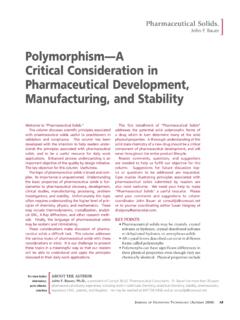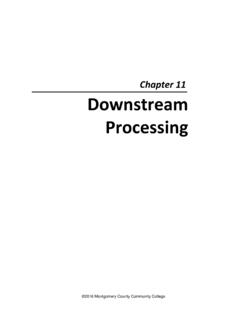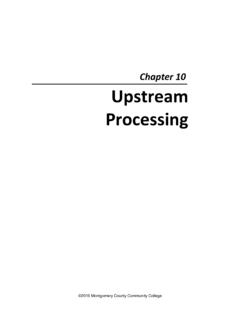Transcription of Behavior of Cells in a Bioreactor - University of Georgia
1 Behavior of Cells in a BioreactorThe growth rate of a population is proportional to the number of organisms present in that population. If each member of that population has the same mass, then the growth rate is proportional to the mass concentration of members (X = cell mass concentration):A. Models to describe cell growth___dXdtvX1. IntroductionNotes:The proportionality constant Pis called the specificgrowth rate. (units are time-1) Pcan be positive (growth) or negative(death). Usually Pis used in the context ofcell growth. Pis a function of nutrient supply andtherefore can be a function of time ( , ifnutrient supply is changing with time).S = substrate concentrationP = product concentrationI = inhibitor concentration2.
2 Empirical models to describe cell growth rateIn general, P= f(S, P, I, X, pH, T, osmotic pressure)Generally, non-segregated, unstructured, deterministic and empirical models are used to describe cell growth + S_____NKN+ NFor multiple substrates(such as nitrogen)..P=a) Monod_____PMAXSKS+ SKS = Monod Constant (typically very small)P=So, P PMAXb) Modified Monod_____PMAXSKS+ KS0S0+ SS0 = Initial SubstrateConcentrationP=_____PMAXSKSXX + SP=c) ContoisPredicts P at low S1X__Predicts P 0 at high Xd) Monod-like NoncompetitiveInhibition _____PMAXSKS+ S_____KIKI+ IP=e) Monod-like NoncompetitiveProduct Inhibition _____PMAXSKS+ S_____KPKP+ PP=Monod model is most widely substrate is consumed by an organism.
3 The mass/energy of the substrate goes towards three uses:B. Model to describe substrate utilizationThe substrate may be converted by the organism into energy for it to maintain its standard of living. This concept is called maintenance requirement. The majority of a cell s maintenance energy goes towards maintaining osmotic and ionic gradients across the cell MaintenanceThe rate of substrate consumed in order to maintain the Cells is proportional to the number of Cells or the mass density:Where mSis the maintenance coefficient. The units of m are (for example) g substrate/g cell ___dSdtvXorMaintenance_ ___dSdt= mSXThe higher the value of the maintenance coefficient, the more substrate goes towards maintaining the culture without contributing to cell mass or product formation.
4 Maintenance is the overhead costs of the organism for doing is defined in terms of any single substrate needed for Cells under non-growth conditions. Usually maintenance coefficients are considered for two substrates carbon (mS) and oxygen (mO).Aerobacter g/ghA. substrate may be used for the production of new cellular components which ultimately become new Cells . The rate of substrate consumed to produce more Cells is proportional to the rate of new Cells produced:2. Cell massCells_ ___dSdtv___dXdtBy convention, the proportionality is written in front of the substrate consumption rate term:Cells_ ___dSdt=___dXdtYX/SorCells_ ___dSdt=___dXdtYX/S____1where YX/Sis the cell yield coefficient.
5 Cell yield coefficients may be written for any substrate:YX/S= g cell formed g substrate consumedYX/O= g cell formed g oxygen consumedCandida g/gCandida utilisacetic YX/SYX/OThe substrate may be used for the synthesis of chemical products. These are usually at the termination of biochemical Products___dPdtVolumetric rate of product formation = QP=___dPdt___1 XSpecific rate of product formation = qP=Some useful terms:There are several relationships which can exist between the rate of product formation (qP) and the specific rate of substrate consumption (qS) or specific growth rate (P).specific rate of substrate consumption (qS)or specific growth rate (P)specific product formation rate (qP)mixed growth associatednon-growth associatednegatively growth associatedIn this case a simple stoichiometric relationship exists between the product formation rate and substrate utilization Growth associatedProducts_ ___dSdtv___dPdtProducts_ ___dSdt=___dPdtYP/SProducts_ ___dSdt=dPdtYP/S____1___YP/S= g product formed g substrate consumedYP/O= g product formed g oxygen consumedGrowth associated products form simultaneously with and as a natural consequence of cell growth.
6 Thus, the rate of product formation is also proportional to growth rate:___dPdtv___dXdtwhere YP/Sis a product yield coefficient based on substrate. Such a yield coefficient can be written for each substrate (and for each product):where YP/Xis the specific product yield :X___dPdt=___dXdtYP/X___X1 QPX=YP/XPqP=YP/XPgrowth associated productsb. Non-growth associatedThe specific rate of product formation is a Mixed-growth associatedqP=DP EQP=DPX EXLuedeking-Piret Equationd. My personal preference, but a lot of workConduct (chemostat) experiment (using different nutrient limitations) at various dilution rates, measure qSand qP, and then come up with an empirical relationship between the specific rate of product formation is a f(P)qP= f(qS)When you have engineered an organism to accumulate a new product, you often do not really know what qPdepends on.
7 4. SummaryThus, the total substrate utilization may be written:To t a l_ ___dSdt=Maint_ ___dSdtCells_ ___dSdtProducts_ ___dSdtTo t a l_ ___dSdt=mSX +____PXYX/S+____QPYP/S= QS___QSXqS = -rS =Consider the following well-mixed system:C. General material balancesFINFOUTFIN= flowrate of fluid into system (vol/time)FOUT= flowrate of fluid out of system (vol/time)V = volume of fluid in system1. DerivationOther key variables (a reminder):X = concentration of Cells (mass/vol)ri= mass rate of igeneration (mass/vol time)S = concentration of substrate (mass/vol)P = concentration of product (mass/vol)W = concentration of water (mass/vol)Four (or more) material balances can be written:Accumulation = In Out + Gena) Cells := FINXIN-FOUTXOUT+ rXVd(VX)dt_____b) Limiting substrate:= FINSIN-FOUTSOUT+ rSVd(VS)dt_____Note: we expect rSto be negativec) Product:= FINPIN-FOUTPOUT+ rPVd(VP)dt_____d) Water:= FINWIN-FOUTWOUT+ rWVd(VW)dt_____2.
8 Common simplificationsa) Concentration of water remains unchangedWIN= WOUT= Wand insignificant water is generatedrW= 0b) Reactor is well-mixedPOUT= PSOUT= SXOUT= Xc) No product and no Cells in feedPIN= 0; XIN= 0d) Cell growth rate is greater than cell deathrate and can be expressed as:rX= PXResults of these simplications:a) Cells := - FOUTX+ PXVd(VX)dt_____b) Substrate:= FINSIN-FOUTS+ rSVd(VS)dt_____c) Product:= - FOUTP+ rPVd(VP)dt_____d) Water:= FIN-FOUTdVdt____D. Batch operationA batch process is a closed culture which occurs when FOUT= 0 and FIN= volume is essentially constant (except for pH control, anti-foam addition, etc.).All nutrients are provided initiallyinto the culture.
9 The Cells are introduced into that culture, and grow until one or more nutrient(s) is exhausted. This one nutrient is often called the limiting nutrient . However, the Cells are essentially never actually limited for their growth during the course of a batch IntroductionReturning to differential equations to describe batch process (FOUT, FIN= 0; V = constant):a) Cells := + PXdXdt____b) Substrate:= + rSdSdt____c) Product:= + rPdPdt____= PXdXdt____In order to use this equation, we need a relationship between Pand S (and other variables as desired).2. Incorporating growth and substrate utilization modelsCells:For example, Monod model for two substrates (S and N):_____PMAXSKS+ S_____NKN+ NP==dXdt____PMAXSX_____KS+ SSo,_____NKN+ NIn order to use this equation, we need an expression forrS, which we have derived + rSdSdt____Energy substrate:-rS =mSX +____PXYX/S+____QPYP/SWe will consider the case where no product is formed (QP= 0).
10 Incorporating two-substrate Monod model into substrate equation:dS____dtPMAXSNX_____YX/S(KS+ S)(KN+ N)= mSX A substrate model may be used for every nutrient. However, typically no other nutrient (like N) is directly incorporated into products (QP= 0), and no other nutrient except oxygen is used for maintenance (mN= 0). Thus,= + rNdNdt____Non-energy substrate:-rN =____PXYX/NdN____dtPMAXSNX_____YX/N(KS+ S)(KN+ N)= In summaryThe three differential equations describing cell growth (X) and substrate utilization (S and N) are:dS____dtPMAXSNX_____YX/S(KS+ S)(KN+ N)= mSX dN____dtPMAXSNX_____YX/N(KS+ S)(KN+ N)= dX____dtPMAXSNX_____(KS+ S)(KN+ N)=___dXdtv___dNdtNoteParameters:mS= g/gh *KS= 10 mg/L = g/L* (S = glucose)KN= g/L PMAX= h-1YX/S= g/g *YX/N= g/g Case I: Carbon-Limited X0= g/L S0= 30 g/LN0= 5 g/LCase II: Nitrogen-Limited X0= g/L S0= 30 g/LN0= 1 g/LSimulated Cases: unpublished data yeast; Cramer et al.







